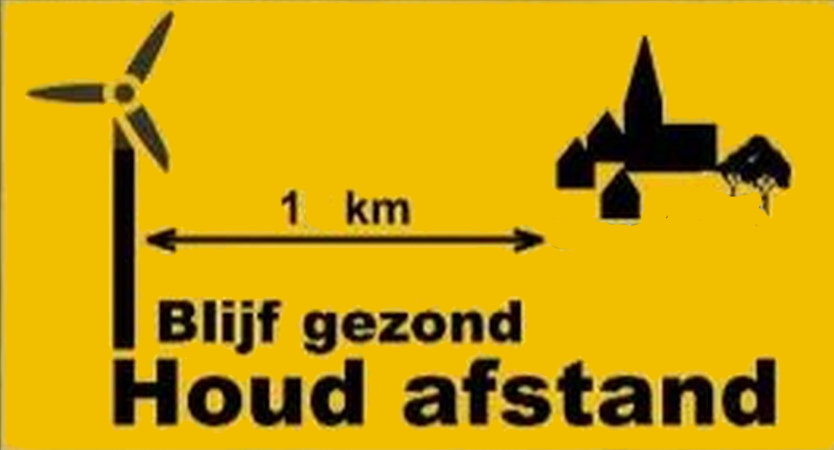
On 21 April 2022, the House of Representatives received a research report on distance standards for wind turbines from DG Climate and Energy. This is a response to an Erkens-Leijten motion since 21 June 2021: " Requests the government to carry out an independent study in the short term into the effects of different distance standards on the health and quality of life of local residents ". That only partially meets that motion, because the Arcadis report does not use health research and does not mention the word quality of life at all.
The NLVOW promotes the interests of people living in the vicinity of wind turbines, in particular through open consultation with government authorities and other interests in the energy transition. The NLVOW is therefore pleased to have been able to participate in a sounding board session to answer questions from the House of Representatives about distance standards. Thanks were able to exchange ideas and make additions. The fact that the final report still bears many traces of what we believe to be old assumptions about space for onshore wind energy, as we see it as part of an ongoing mentality transition. However, huhThe final result and the accompanying letter leave room for comments from the interests of citizens, from European and Environmental law, and therefore also for the benefit of the House of Representatives.
In the following, NLVOW would like to point out the following aspects, which deviate from the Arcadis report on Distance Standards:
1. Duty of care, precautionary principle according to (EU) Environmental regulations missing
2. Ten years of wrong Lden, no independent enforcement possible, not again
3. Noise nuisance, but integral effects certainly also lead to wide distance
4. Spread in outcomes not due to distance standards but due to inaccurate noise calculations
5. The Netherlands had the shortest distance, other countries are prudent with regard to integral effects
6. Placement options are plentiful, even with wide distance standards due to sufficient alternatives
7. Other comments, including financial consequences, complete prevention of nuisance from cast shadow and obstacle lighting
In addition, the NLVOW wanted to contribute at its own expense with a second opinion conducted by DGMR on the current Arcadis report. In the following this is referred to as **.
For more than 10 years, there has been a shortage of care for citizens under the “Amendment Activities Decree 2011” because of placement options. Now that there are ample alternatives for placement options for more than sufficient wind energy, for example in the North Sea, it is important to restore the duty of care. Especially now that health research is still several years away and it is uncertain whether it can be shown that NO damage to health occurs, there is, together with many other effects, reason for safe, strict distance standards.
See if necessary older items about this on this website: here , here and here .
We have sent the contents of the following as a supplementary report to, among others, the House of Representatives. See downloads below.
Prudence, precaution and duty of care
A wind turbine is a mega industrial building, not enclosed, strongly rotating, radiating free sound over the entire rotor surface of 1-2 hectares. That's true in every area and every layout. A bulldozer's source strength is higher in the sky than anything else. A wind turbine (park) surpasses every conceivable other industry in this respect. A wind turbine is therefore a very special spatial element that deserves appropriate standardization.
First of all, we think it is necessary to emphasize better that the various EU Directives and the WHO opinions not included in the report** [ ], all call for noise reduction, so as to promote overall health and quality of life and “ to provide a high level of environmental protection”. Contrary to what this Arcadis report mentions, these targets also apply to wind turbines, under the term “industry”. This is in line with our Dutch duty of care in environmental legislation, to choose the safe side where available or where uncertainties exist, according to the principles of precaution and prudence. More broadly, the Treaty (TFEU) [ ] provides that “Community environmental policy is based in particular on the precautionary principle and the principle of preventive action,
A second reason for this stems from the chaos that sound engineers Europe-wide have apparently caused or have not been able to normalize. Every form of noise standard appears to vary per country and per study. The Arcadis report, written from a sound technology perspective, also shows how unguided sound calculations lead to large variations. This concerns different units and different transfer formulas, but also a variety of additional matters such as area types, air humidity, etc. Incidentally, this phenomenon also occurs in and between various planning studies, which can use arbitrary source strengths, mitigations and transfer. The unsolicited sample calculations in the Arcadis report only confirm the insight that noise standards and calculations are inimitable and give rise to major inaccuracies. This points to the need for a safety margin of the order of 5 dB(A) ** which noise reports therefore apparently require. And with that the need to arrive at clear and robust distance standards.
A third reason for the duty of care is the lack of health research from RIVM for several years to come. The question is whether it can be proven whether adding wind turbine noise to homes does NOT cause health damage. Chapters on dose-effect relationships have therefore been superfluously added in the Arcadis report. They can be a proxy for the measure of health damage. RIVM and WHO point out that any form of nuisance is a form of health damage, and that it is a right to sleep with an open window.
However, these relationships are statistically irresponsible in sample size, interviewee variety, and indoor/outdoor confusion. In the meantime they concern low wind turbines that are no longer available **. The Activities Decree also secretly made use of indoor standards (unless low-frequency noise), which were never used in the noise world, instead of outdoors. It also appears that studies such as Pedersen 2004 have not been included in the confidence intervals provided by TNO or Michaud in this Arcadis report. This means that there is every reason to use only the safest upper bound of dose-effect relationships. Basis taken from Arcadis report:
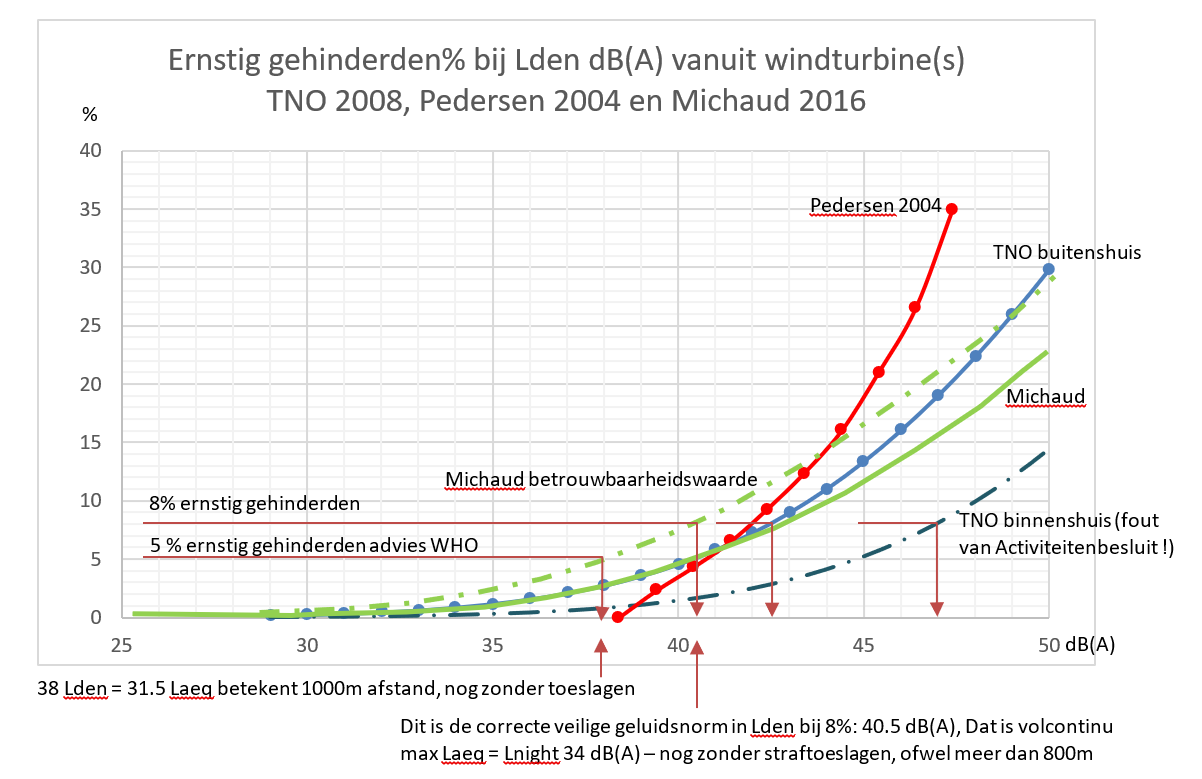
If there was already motivation in the Activities Decree to consider 8% seriously annoyed as normal (for road traffic due to limited budgets for measures), then this leads with Michaud to a noise limit value of 40.5 Lden or better 34 dB(A) Laeq per short unit of time. , valid for a whole day. The WHO recommends working with 5% “severely annoyed persons”, which in terms of noise nuisance alone already leads to a distance standard of at least 1000m (see graph below).
The words “duty of care, precaution, prudence” wrongly do not appear at all in this Arcadis report, despite the guidelines that have since been included, and only partially included WHO advice. Even the confirmed jumble of sound technology did not lead to the comment that a safety margin is necessary. The additional chapter on dose-effect relationships, which was not requested from the motion, also did not lead to caution regarding the spread of results.
The wrong Lden
Only two of the countries surveyed apply a limit value expressed in Lden. With regard to Lden, the Activities Decree very wrongly pointed to an EU Directive [ ] that prescribes that mapping and reporting from the countries to limit noise must be supplied, which the Netherlands has never complied with, and that prescribes the prevention of health damage through nuisance. In addition, the WHO stated in 2018 [ ] that Lden cannot be used for wind turbine noise to characterize health effects. Lden's practice in the past period has led to unenforceable variations in noise, because these are no less than annual averages.
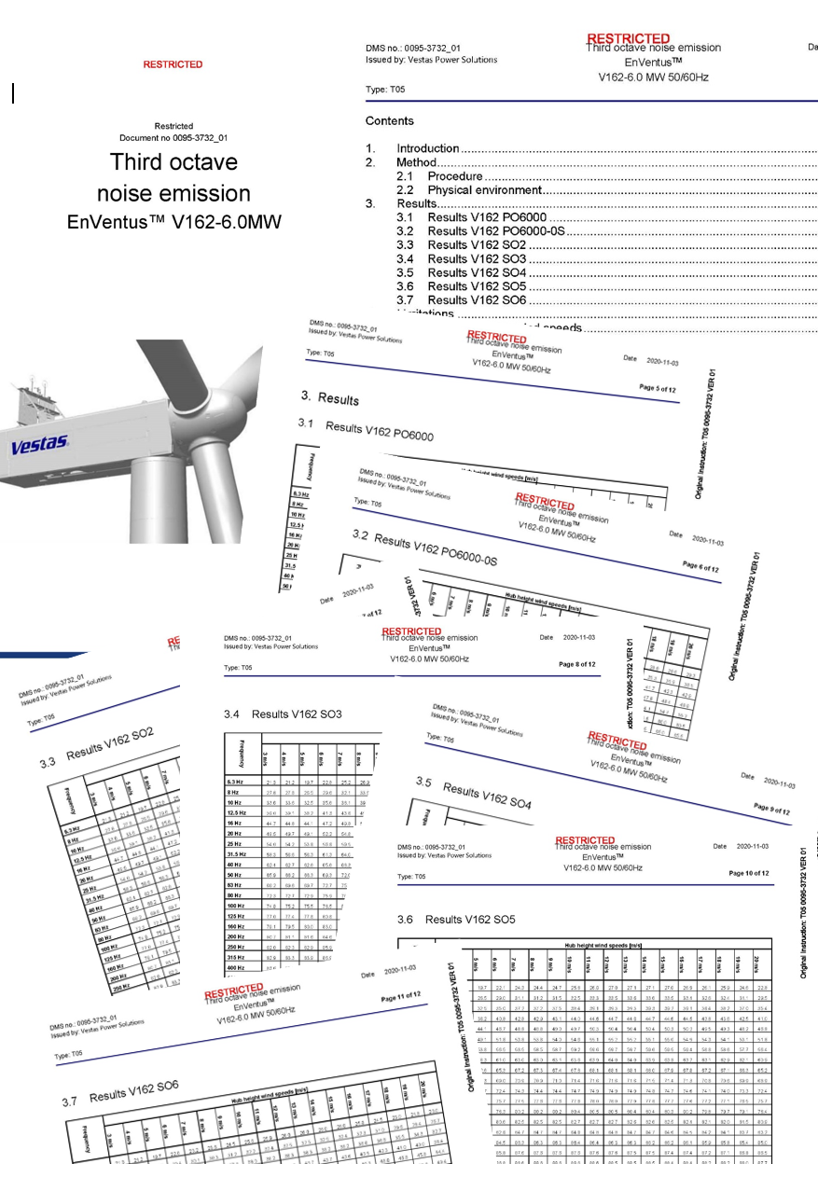
The environmental services were not even allowed to carry out immission measurements under the Activities Decree, and they themselves almost never measured source strengths of wind turbines, while manufacturers stated that new types only extrapolated from smaller turbines. Those turbine manufacturers immediately added spare pages to their “certificates” of source strengths, each with a fictitious fixed measure in dB(A) less. For example, misuse arose in the planning phase because any consultancy could plan windmills a short distance from homes, stating that they would apply a “necessary” arbitrary “mitigation”. Lden's practice is that these “silent modes” cannot be verified computationally, or that an hour of standstill during the night is sufficient.
Lden also ignores “punitive surcharges” that 19 of the 25 countries surveyed apply in their standards for tonal and/or impulse noise, including at night **. The phrase in Arcadis' report that this may involve 6 dB(A) lower standards has not been incorporated by Arcadis in their final graphs. Lden therefore leads to miscommunications that are not noticed too quickly and the EU target of noise reduction cannot be enforced with Lden.
More than just sound
Drop shadow is the only nuisance aspect included in this Arcadis report, in addition to noise. The report is also clear about this: a separate obligation for a complete standstill regulation provides for the prevention of all nuisance, while this only requires a very limited permillage of the annual production **.
The Arcadis report does not include other aspects in the required distance, which are only partly mentioned: visual nuisance, landscape, suppressiveness, monumentality of processes that have gone unjust, skewed distribution of benefits and burdens, need for compensation, financial damage on a working day due to sleep disturbance. It is precisely these integral aspects that 13 of the 25 countries surveyed have included in their distance standards**. TNO 2022 [ ] has published that the RES1.0 causes a damage to the value of the home of 15.5 billion euros. Bavaria, Denmark and Poland also want to avoid this financial infringement with a robust distance standard, because there are alternative locations for wind turbines. However, the word “quality of life” does not appear in the Arcadis report without quoting the motion.
The so-called Danish model still lacks a more extensive treatment in this Arcadis report, partly because a combination of standards has been arranged there. Denmark, for example, has a clear regulation for exceeding the distance standards for the demolition of wind turbines or expropriated homes. The Netherlands did not appoint any sanctions and therefore no guideline value below a limit value, as is customary in environmental legislation. Denmark also sees the garden and terrace as a living environment to be protected.
Wrong comparison between distance standards and noise standards
The motion only asks for distance standards, but the Arcadis report wants to show that applying distance standards alone would not meet legal protection or even pose a “risk” of “too great protection” and therefore too little placement space on land. It has already been stated above that noise standards and calculations lead to a fictitious spread, according to NLVOW's finding between two noise agencies for the same project of up to 5 dB(A) [ ]. This therefore corresponds to a need for an accuracy margin of 5 dB(A) noted above. A noise standard in Lden in particular leads to too much interpretation and too little enforceability.
It is therefore surprising that this report turns this around, stating that distance standards offer unequal protection in the varying situations. This is presented too elaborately, via the uncertain noise calculations themselves and the "many factors and many variables" referred to by the Arcadis report. The spread from many variables is due to choices of source strengths and calculation effects and even large variation in calculation methods **, not because of the distance itself! A great deal of spread averages out over time with varying wind direction, wind strengths, meteorological and local situations. Distance is not to blame for this, but the elusive noise standards, and this is precisely the reason to first secure with a clear and robust distance standard. The Arcadis report also mentions that strict distance standards can provide sufficient protection, including effects other than noise. This should have been made clear in the conclusions and summary.
Furthermore, the Arcadis report suggests that distance standards would almost exclusively protect the “visual aspect”. That has been formulated completely differently for the Federal States, Denmark, and in particular Bavaria and Poland: a great distance helps against all kinds of ailments, to prevent the need to expropriate houses, and in the first place a clear basic protection against noise pollution, see after this. They are indeed scientifically motivated [ ] with an integral impact assessment to a distance standard of 10 times tip height, with current mills order 2000 to 2500 meters.
Little customization can indeed be provided in a "clear distance standard", but it is rather important to limit the chaos from "many variables" and the calculation theories to the worst-case, i.e. to the safe side, so that in changing meteorological situations ( wind direction, stratification, humidity, etc.) all homes are equally protected, regardless of the degree of development (urban or rural areas). This also applied in the Netherlands until the inclusion of wind turbines in the Activities Decree **. If necessary, it is still possible to differentiate according to (original) background noise or average wind strength, so that the silence in the Netherlands is preserved instead of becoming cluttered.
The use of quieter wind turbines is now limited to reducing energy production at full load (quieter modes through pitch adjustment). This cannot be called an innovation. In order to promote quieter wind turbines or to counteract mechanical disturbances, a requirement can be made for BAT to be regularly updated and for maintenance. Adding noise standards would again bring "spreading" and difficult control and enforceability. It may therefore suffice to use sufficiently broad distance norms, with perhaps some differentiations, to compensate for any disadvantages of distance norms **.
The Arcadis report intends to add sample wind farm calculations, which suggest too much of a sham accuracy**. The resulting “spread” of, among others, the following Figure 15 shows the upper limit with which some homes, but which vary over time, are affected by virtually all homes. This necessitates a safe approach, so that the upper bound must be used prudently, in order to be covered for different geometric and meteorological conditions. For the old Dutch standard of 47 dB(A) and the minimum required precautionary standard of 40.5 dB(A) above, safe distance standards follow analogous to the German Federal Countries, Denmark and Poland:
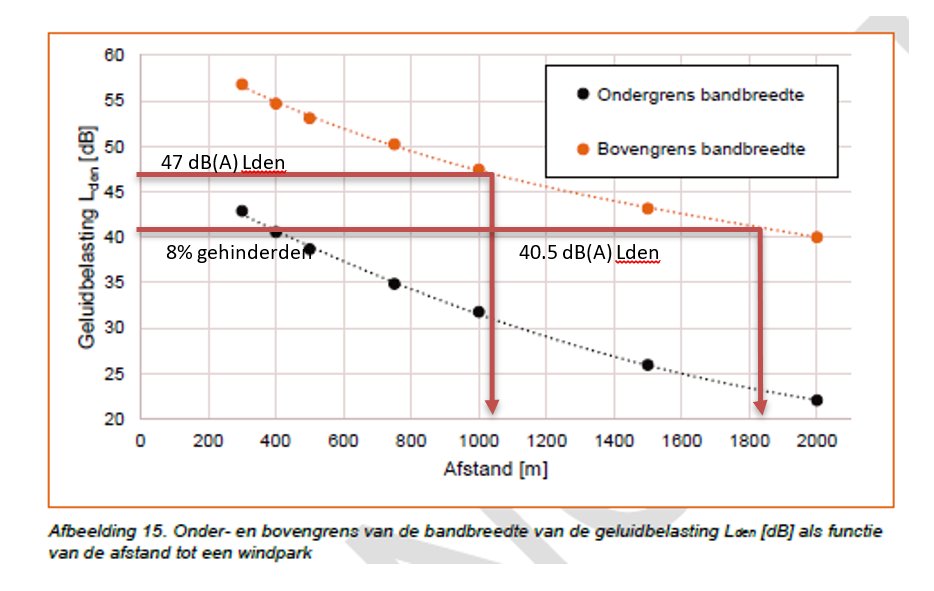
Translation to distances
The sound engineering agencies did not want to translate noise standards into distance standards. The reason would be that each country has adopted its own, unknown customs/jurisprudence with regard to impulse noise allowances, situation assessment, etc. and follows a local method of calculation. So there is something very wrong with sound standards. However, with some moderate presets one can report well in distances only:
- The basis is the foreign overview of Arcadis in this report, supplemented with an earlier publication by the author [ ] and after comparison with distances from other studies of M+P 2015, IG-Noise 2019, EU-JRC 2018 [ ] **
- considering only one turbine type, which is still common in 2022: tip height 220m, rotor diameter 160m, L0=105dB(A) (that is moderate compared to the average available)
- choice for the strictest situation, from the point of view of precaution and from the point of view of equal civil rights and as is common in the Netherlands
- existing background noise 30 dB(A), basis if increase is standardized
- surcharges/penalty reductions have only (and only moderately) been applied where so stated, it may apply more often **
- for combined requirements: the strictest, from the ERVM to apply to every home at any time
- Laeq is what day and night is maximum, so Laeq=Lday=Levening=Lnight
- transfer according to Manual for measuring and calculating Industrial noise Lr=L0-20*log(r)+0.005*r+9.1
In the graph below from NLVOW, black distance bars are countries with a pure distance standard, blue distance bars are based solely on noise immission requirements. Yellow bars arise from height requirements only and gray bars from combinations.
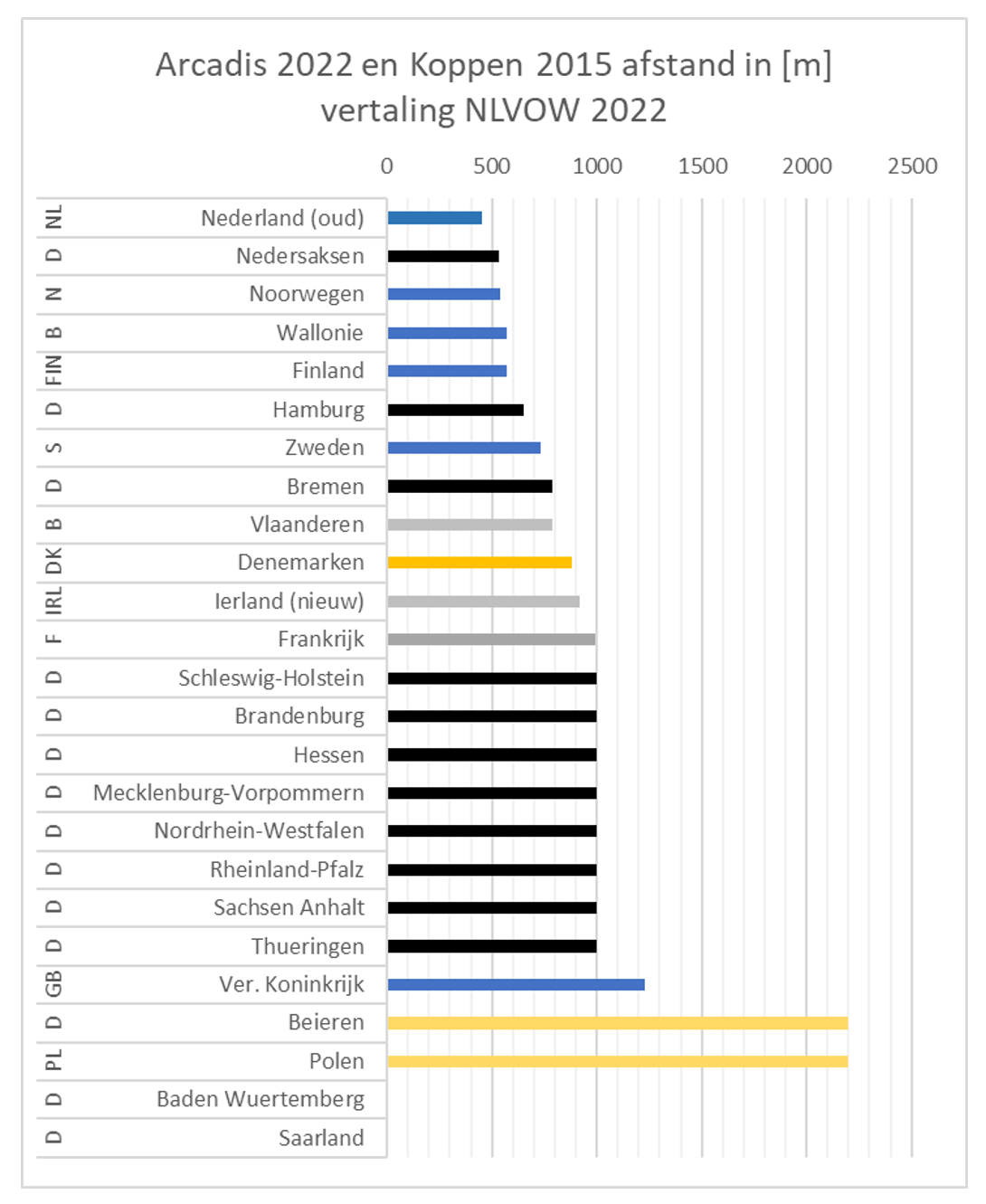
The majority of the 25 countries studied here have a distance standard, whether or not as a basis for a combination with the noise standard, only 2 had a standard in Lden. It is striking that the Netherlands provides extremely poor protection, and that the equally densely populated North Rhine-Westphalia maintains more than double the distance [ ]. Figure 1 of the Arcadis report also shows a number of distances that do not correspond to the country descriptions, where there are no exceptions to hard distances.
A greater distance appears to result from not only including health aspects from noise, but also from including effects on quality of life and the prevention of compensation from the distribution of benefits and burdens.
It should also be noted that Denmark, Bavaria and Poland do have extensive scientific support for their prudent distance standards, rather than being referred to in this Arcadis report as “on the basis of an opinion article” [ ]. Contrary to the Arcadis report, the federal state of Lower Saxony also proposes a minimum distance of 1,000 m to homes from 07.06.2021, because "looking at specific situation" deviates from the principle of "clarity" and acceptance for "repowering" is needed [ ]. The federal states are also allowed to (continue to) use a distance standard from the current Federal Environment Minister.
Other Effects
- Hindrance from shadow casts is easy to regulate with a separate standard for standstill regulation 0% nuisance from shadows, which also costs little according to the report.
- Also on the basis of BBT and ALARA, another independent standard is that the nuisance of (red) obstacle lighting can also be reduced to almost nil with automatic approach detection.
- Some countries, including the Netherlands, have an exception for “van de miller” company homes. However, this usually does not take place in a zoned industrial area. Just like uninhabitability, the children or future tenants of such an enterprising miller should therefore be protected in health just as much as in other homes.
- Tables 1 and 2 and graphs Figures 8, 9 and 10 in this Arcadis report show some significant omissions from what is noted in the land description. This mainly concerns limitations to the increase in relation to background noise and also that no surcharge/discount for the nuisance sound type (tonal or impulse) has been processed **. The contrast between urban and rural areas is un-Dutch (REVM).
- It should be considered to set a maximum Laeq in dB(C) for low-frequency noise indoors, as in Denmark, which can therefore be measured as immission at any time, or can be logged for a long time if desired.
- This Arcadis report does not fully meet the question posed in the motion. The report title has therefore been adjusted to without effects on health and quality of life. This can be accommodated prudently with wide margins, under the adage that no evidence has been provided that noise from wind turbines would NOT cause any health damage. Taking the distance standard broadly also provides protection against other effects.
- Fortunately, in the final version of the Arcadis report, the superfluous sector comments about 1 or 2 wind turbines and municipal own standards disappeared.
letter to parliament
The Arcadis report has been presented to the House of Representatives with a cover letter, in which the above deficiencies of the Arcadis report are repeated. In particular, it is incorrect that distance standards are the cause of spreading protection, because that spread is precisely the result of noise calculations.
The letter to parliament mentions in one sentence as if it is interchangeable: “This involves paying attention to the precautionary principle and examining what the different standards could mean for achieving the climate goals.” Likewise, it is not appropriate for the Ministry of Energy & Climate to want to do justice to local residents on the one hand, but also to "Dutch people who are concerned about the Climate", as if these are two extremes, on the contrary. It is wrong not to mention the duty of care towards every citizen, nor to recognize the EIA necessity of alternatives such as sufficient installation options for offshore wind, with at least nil effect on the health and living environment of local residents.
Following on from this, a number of paragraphs were unexpectedly added in the letter to parliament that are not directly related to the distance standards. In the sounding board sessions conducted, a consideration of installation space for wind energy was deliberately left out of the report, which is, after all, a competence of the House of Representatives itself. Now that the letter to parliament does make statements about onshore wind, this information must be complete and correct. Neither is the case and therefore not in the interest of the energy transition:
- The Netherlands is the most populous country in Europe
- The Netherlands has approximately 10 times more sea surface per inhabitant than neighboring countries
- Wind from sea is close to demand and can be connected with cheap sea cables
- Grid congestion on land is expensive and slow to resolve and is not served by wind, which, like solar PV, produces the most during the day
- The North Sea offers space for more than 70 GW in already realized planning, enough for more than double the TWh that is envisaged in the latest targets for 2030
- It is not appropriate for the letter to parliament to mention unproven objections to offshore wind: shipping, “food transition” and nature conservation have already been weighed up in national policy.
Conclusion NLVOW
This Arcadis report ignores the motion in parts and goes further than the motion and/or the research question in other parts, but this has not been elaborated on on a scientific basis **. Pretending to the House of Representatives the reversal that noise standards are exact and distance standards are not, is not scientific and leads to a departure from national and international obligations under the Duty of Care. In general, this report from Arcadis confirms that many standards abroad have opted for clear and above all strict, safe distance standards, which tackle the chaos of noise figures and calculations. And therefore be prudent on all effects, and in particular on health and quality of life, by relating a distance standard to the tip height. Any noise standard serves as an additional rear catcher,
Literature
Second opinion for NLVOW performed by DGMR on the current Arcadis report dated March 22, 2022, reference to this above via ** (see download below)
WHO :
“Night noise guidelines for Europe”, WHO 2009 “Burden of disease from environmental noise,
“Quantification of healthy life years lost in Europe”, WHO 2011
“Environmental Noise Guidelines for the European Region”, WHO 2018
"Article 130r(2)" TFEU
“DIRECTIVE 2002/49/EC of the European Parliament and of the Council on the assessment and management of environmental noise”, 25-6-2002
“The expected impact of wind turbines on house prices in the Netherlands. A spatial analysis for the period 2020-2030”, TNO 2022 P10374 https://publications.tno.nl/publication/34639293/2ZNonx/TNO-2022-P10374.pdf
"Acoustic research Windpark Eekerpolder", Arcadis, 2-11-2021 and "Noise calculations for wind farm N33 based on measured noise data", Pondera, 6-7-2021: two measurements with up to 5 dB(A) difference in emissions to the same homes from same wind farm N33
Bavaria:
Bayerischer Landtag 17. Wahlperiod, Drucksache 17/2137, „Gesetzentwurf der Staatsregierung zur Änderung der Bayerischen Bauordnung und des Gesetzes über die behördliche Organization des Bauwesens, des Wohnungswesens und der Wassregierung zur nderung der Bayerischen Bauordnung und des Gesetzes über die behördliche Organization des Bauwesens, des Wohnungswesens und der Wasswesens und der Wasswesens und der Wasserwirtschaft
” Planung und Genehmigung von Windenergieanlagen (WEA) (Windenergie-Erlass – BayWEE)“, 7/19/2016
Poland:
“Position of the National Institute of Public Health – National Institute of Hygiene on wind farms”, pools RIVM, 2016, with bibliography https://www.ft.dk/samling/20151/almdel/mof/bilag/474/ 1639095.pdf
Previous comparable reports on distance standards :
”Differences in noise regulations for wind turbines in four European countries”, M+P and Mueller-BBM, Euronoise 2015
“International Legislation for Wind Turbine Noise”, Arcadis/Koppen, Euronoise 2015
“ Wind potentials for EU and neighboring countries”, EU JRC 2018
“Overview of critical noise values in the European Region”, M+P.BAFU.18.01.1, 9-10-2019
Nordrhein Westfalen:
„Zweites Gesetz zur Änderung des Gesetzes zur Ausführung des Baugesetzbuches in Nordrhein-Westfalen“, Landtag Nordrhein-Westfalen 17. Wahlperiod Drucksache 17/13426, 21-4-2021
„Geltende Erlasse (SMBl. NRW.) mit .2022, „Erlass für die Planung und Genehmigung von Windenergieanlagen und Hinweise für die Zielsetzung und Anwendung (Windenergie-Erlass)“ 8-5-2018, Arcadis has taken over from Fachagentur Windenergie an Land, January 2021, but NRW has been incorrectly modified from it: 1000m was a proposal, not implemented
Niedersachsen:
“1000m-Mindestabstand für WEA in Saxony”, 26-1-2022, https://w3.windmesse.de/windenergie/pm/39686-prometheus-kanzlei-energierecht-anwalt-sachsen-bundesland-abstand-gesetzentwurf- windkraft-ausbau-wohnbebauung-genehmigung-einzelfall 26-1-2022
Position Paper NLVOW inzake klankborden over afstandsnormen
Aanbiedingsbrief EZK aan Tweede Kamer 21 april 2022
Eindrapportage Arcadis over Afstandsnormen windturbines
Nawoord van NLVOW zoals opgenomen in Eindrapport
Brief en aanvullende rapportage aan TK van NLVOW
Second Opinion van DGMR voor NLVOW
Toelichting grafiek afstanden NLVOW